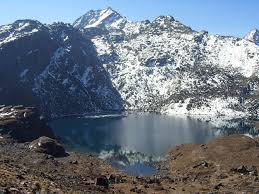Gosaikunda is an alpine freshwater oligotrophic lake in Nepal's Langtang National Park, located at an altitude of 4,380 m (14,370 ft) above sea level in the Rasuwa District with a surface of 13.8 ha (34 acres). Together with associated lakes, the Gosaikunda Lake complex is 1,030 ha (4.0 sq mi) in size and has been designated a Ramsar site in September 2007.
 The lake melts and sips down to form the Trishuli river and remains frozen for six months in winter October to June. There are 108 lakes in this area, small to medium in size. The challenging Lauribina La pass at an altitude of 4,610 m (15,120 ft) is on its outskirts.
The lake melts and sips down to form the Trishuli river and remains frozen for six months in winter October to June. There are 108 lakes in this area, small to medium in size. The challenging Lauribina La pass at an altitude of 4,610 m (15,120 ft) is on its outskirts.
 The popular start to the trek to Gosaikunda are in Dhunche Village or Syabru Besi both from the Langtang side. Alternatively, trekkers may also start from Sundarijal, which lies on the outskirts of Kathmandu.
The popular start to the trek to Gosaikunda are in Dhunche Village or Syabru Besi both from the Langtang side. Alternatively, trekkers may also start from Sundarijal, which lies on the outskirts of Kathmandu.
If you are starting from Dhunche, the first day involves a long steady climb to reach Chandan Bari, which is at a height of about 3200 meters. On the second day, one reaches Laurebinayak at about 3700 metres. At this point, some trekkers choose to climb ahead to Gosaikund, though altitude sickness is a concern due to rapid ascent. Many trekkers choose to stay at Laurebinayak which also provides excellent sunset and sunrise views of the Langtang and Ganesh Himal.
 The descent from Gosaikund to Sundarijal takes about four days. The first day involves a short climb to Laurebina pass (4600 metres) and a rapid descent to Phedi or Teashop. Depending on pace, there are options to stay at Tharepati, Mangengoth, Kutumsang and afterwards at many village habitations every two hours. Accommodation is quite easily available, though basic and a variety of food options are also available at tea house stops.
The descent from Gosaikund to Sundarijal takes about four days. The first day involves a short climb to Laurebina pass (4600 metres) and a rapid descent to Phedi or Teashop. Depending on pace, there are options to stay at Tharepati, Mangengoth, Kutumsang and afterwards at many village habitations every two hours. Accommodation is quite easily available, though basic and a variety of food options are also available at tea house stops.
The trails are very well marked, except between Ghopte and Thorepati, where chances of losing ones way are real.
Trekking to Gosaikunda
If you are starting from Dhunche, the first day involves a long steady climb to reach Chandan Bari, which is at a height of about 3200 meters. On the second day, one reaches Laurebinayak at about 3700 metres. At this point, some trekkers choose to climb ahead to Gosaikund, though altitude sickness is a concern due to rapid ascent. Many trekkers choose to stay at Laurebinayak which also provides excellent sunset and sunrise views of the Langtang and Ganesh Himal.
The trails are very well marked, except between Ghopte and Thorepati, where chances of losing ones way are real.







 5:07 AM
5:07 AM
 Niraj Luitel
Niraj Luitel
